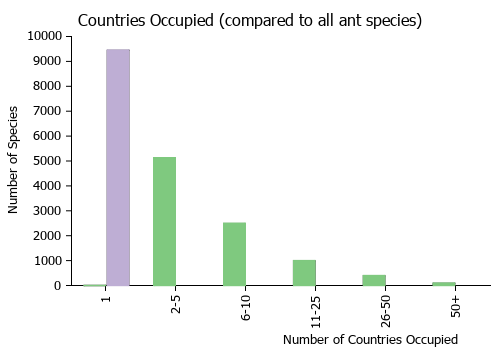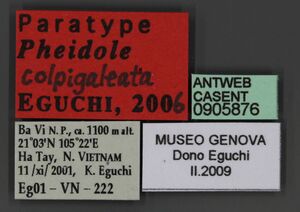Pheidole colpigaleata
| Pheidole colpigaleata | |
|---|---|

| |
| Scientific classification | |
| Kingdom: | Animalia |
| Phylum: | Arthropoda |
| Class: | Insecta |
| Order: | Hymenoptera |
| Family: | Formicidae |
| Subfamily: | Myrmicinae |
| Tribe: | Attini |
| Genus: | Pheidole |
| Species: | P. colpigaleata |
| Binomial name | |
| Pheidole colpigaleata Eguchi, 2006 | |
This species inhabits forest from lowland to hilly areas (ca. 1200 m alt.), and nests in rotting twigs and small wood fragments. Majors serve as repletes (e.g., Eg02-VN-038, -039). Colony Eg01-VN-222 (the type series) stored many small seeds inside the nest. (Eguchi 2008)
| At a Glance | • Replete Workers |
Identification
This species is characterized among Indo-Chinese species by the following characteristics:
- in the minor dorsal and lateral faces of head and mesosoma punctured
- in the major hypostoma in the middle with a conspicuous median and a pair of conspicuous submedian processes
- in the major frontal carina well developed horizontally
- in the major and minor promesonotal dome lacking a conspicuous prominence/mound on its posterior slope.
The major of P. colpigaleata is very similar to that of Pheidole nodgii and its relatives, e.g., Pheidole tjibodana, Pheidole magrettii and Pheidole retivertex, but is well distinguished from the latter three which have hypostoma in the middle with a well-developed median process only. The major of P. colpigaleata is also similar to those of Pheidole rabo, Pheidole zoceana and Pheidole parva, but is well distinguished from the latter three which have frontal carinae almost absent or vestigial. (Eguchi 2008)
Keys including this Species
Distribution
Known from North Vietnam.
Latitudinal Distribution Pattern
Latitudinal Range: 21.21444444° to 14.9°.
| North Temperate |
North Subtropical |
Tropical | South Subtropical |
South Temperate |
- Source: AntMaps
Distribution based on Regional Taxon Lists
Oriental Region: Vietnam (type locality).
Distribution based on AntMaps
Distribution based on AntWeb specimens
Check data from AntWeb
Countries Occupied
| Number of countries occupied by this species based on AntWiki Regional Taxon Lists. In general, fewer countries occupied indicates a narrower range, while more countries indicates a more widespread species. |

|
Estimated Abundance
| Relative abundance based on number of AntMaps records per species (this species within the purple bar). Fewer records (to the left) indicates a less abundant/encountered species while more records (to the right) indicates more abundant/encountered species. |

|
Biology
Castes
Worker
Images from AntWeb
   
| |
| Paratype of Pheidole colpigaleata. Worker. Specimen code casent0905876. Photographer Will Ericson, uploaded by California Academy of Sciences. | Owned by MSNG, Genoa, Italy. |
Nomenclature
The following information is derived from Barry Bolton's Online Catalogue of the Ants of the World.
- colpigaleata. Pheidole colpigaleata Eguchi, 2006: 116, figs. (s.w.q.) VIETNAM. See also: Eguchi, 2008: 14.
Unless otherwise noted the text for the remainder of this section is reported from the publication that includes the original description.
Description
Worker
Eguchi (2008) - Major (data from the original description). — HL 1.21–1.29 mm, HW 1.16–1.24 mm, CI 92–96, SL 0.60–0.63 mm, SI 48–53, FL 0.74–0.78 mm, FI 61–66. Minor (data from the original description). — HL 0.53–0.58 mm, HW 0.50–0.54 mm, CI 91–95, SL 0.51– 0.56 mm, SI 98–106, FL 0.53–0.58 mm, FI 106–110.
Major — Head in lateral view hardly or weakly impressed on vertex; anterior part of frons longitudinally rugose; posterior part of frons, vertex and dorsal and dorsolateral faces of vertexal lobe reticulate; frontal carina well developed, partly overhanging antennal scrobe; median longitudinal carina of clypeus absent, or present but inconspicuous; median, submedian and lateral processes of hypostoma conspicuous; outer surface of mandible (excluding basal area) smooth, bearing sparse, very short appressed hairs; antenna with a 3-segmented club; maximal diameter of eye longer than antennal segment X. Promesonotal dome in dorsal view rugoso-reticulate transversely or reticulate irregularly, in lateral view lacking a conspicuous prominence or mound on its posterior slope; humerus moderately produced laterad; the dome broader at the humeri than at the bottom. Petiole (much) longer than postpetiole (excluding helcium); postpetiole not massive, in lateral view with its anteroventral part acutely produced. First gastral tergite largely smooth, but usually with a weakly sculptured area around its articulation with postpetiole.
Minor — Dorsal and lateral faces of head largely punctured, often overlain by weak rugoso-reticulation; anteromedian part of frons (just behind frontal triangle) dimly punctured; preoccipital carina inconspicuous or very weak dorsally; median part of clypeus smooth and shining; median longitudinal carina of clypeus absent, or present but inconspicuous; antenna with a 3-segmented club; scape usually exceeding posterior margin of head by the length of antennal segment II or more; maximal diameter of eye as long as or a little longer than antennal segment X. Dorsum of promesonotal dome well punctured and often overlain by weak rugoso-reticulation, or well reticulate with enclosure weakly punctured; lateral face of the dome, mesopleuron, metapleuron and lateral face of propodeum punctured well; the dome in lateral view lacking a prominence/mound on its posterior slope; humerus of the dome in dorsal-oblique view very weakly produced laterad; propodeal spine small, elongate-triangular. Petiole longer than postpetiole (excluding helcium); postpetiole not massive, in lateral view somewhat globular.
Type Material
Eguchi (2008) - Holotype: major, Ba Vi N.P., Ha Tay, Vietnam, Eg01-VN-222, IEBR, examined; paratypes: 11 majors, 13 minors & 1 dealate queen, same data as holotype, Entomological Collection of the Institute of Ecology and Biological Resources, Musee d'Histoire Naturelle Genève, Museum of Comparative Zoology, The Natural History Museum, Entomological Collection of Faculty of Science & Katsuyuki Eguchi, examined.
References
References based on Global Ant Biodiversity Informatics
- Eguchi K. 2006. Six new species of Pheidole Westwood from North Vietnam (Hymenoptera, Formicidae). Revue Suisse de Zoologie 113:115-131
- Eguchi, K. "Six new species of Pheidole Westwood from North Vietnam (Hymenoptera, Formicidae)." Revue Suisse de Zoologie 113 (2006): 115-131.
- Huong N. T. T., P. V. Sang, and B. T. Viet. 2015. A preliminary study on diversity of ants (Hymenoptera: Formicidae) at Hon Ba Nature Reserve. Environmental Scientific Conference 7: 614-620.

